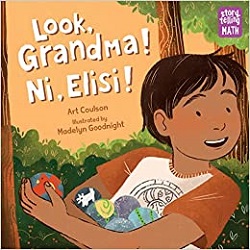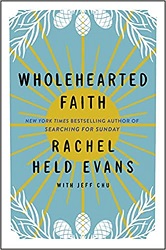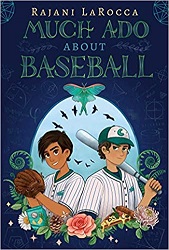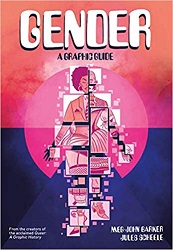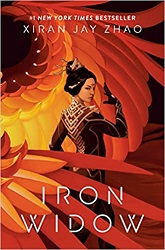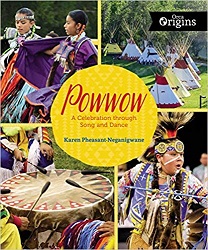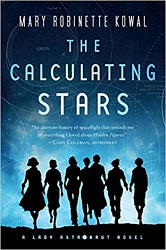 The Calculating Stars
The Calculating Stars
by Mary Robinette Kowal
Tom Doherty Associates, 2018. 431 pages.
Review written September 3, 2021, from my own copy purchased via amazon.com
Starred Review
I tend to love novels where the main character is a mathematician, and when that main character is a woman, that love goes over the top.
The Calculating Stars is set in 1952, featuring Elma, a woman who was a WASP pilot and now works as a computer for NACA, the National Advisory Committee for Aeronautics. Her husband is a lead engineer for NACA.
Yes, this is a different timeline from the one we’re living in – and as the book begins, a meteorite strikes the earth, landing in the Chesapeake Bay outside Washington, DC – which is completely wiped out.
Elma and Nathaniel are in the Poconos when the meteorite strikes. I love the way they both know enough about explosions to know it is not an atomic bomb because the radio continues to play, so they know there wasn’t an electromagnetic pulse. Since an earthquake hits four minutes later, they figure out it was a meteorite and know to get to shelter before an air blast hits. This tells the reader these are highly intelligent scientists – but in an extremely tense scenario.
When they do get to safety, after much difficulty, much of the East Coast has been obliterated. As Elma is doing calculations to figure out what the meteorite was made of – she realizes that earth is in trouble. After some years of extreme cold, things are going to heat up until earth is uninhabitable.
So the rest of the book happens in 1956 and is about the push to go into space – much more quickly than happened in our timeline. Because if those calculations are correct, humans are going to need to build colonies off our home planet.
Elma is an experienced pilot and a genius mathematician – but it’s 1956, and she’s a woman. Many believe that a woman’s place is in the home. Can she prove she has what it takes to become an astronaut? And doesn’t anybody understand they’re going to need women in space to establish colonies, anyway?
This book had me following the gripping storyline all the way through. Elma’s voice telling the story is practical but engaging. I love the way she built in actual things about the space program in our timeline – for example that engineers were male but human computers were female – and that women were allowed to train to be astronauts but were not accepted – and the discrimination that was prevalent at that time. All of this is built into what feels like a very realistic story.
It was disconcerting to read about a disaster that would render earth uninhabitable at the same time fires are raging and huge hurricanes are striking and a pandemic is killing people all over the world. I thought it was just as well she set the disaster in the past so it didn’t feel like something that might soon happen. I could reassure myself this was just fiction!
One thing puzzled me a little after I finished the book. Elma and her husband are young and healthy, and they have lots of sex throughout the book. The book covers five years, but Elma never gets pregnant. Perhaps she’s on birth control pills (maybe developed earlier in that alternate reality?), but she sees a doctor and doesn’t talk about that. And medication for anxiety becomes a big issue for her career. Plus at one point she vomits from anxiety and her husband thinks she’s pregnant, but she tells him she just had her period a week ago. If they’re taking steps not to be pregnant, why would he think that, but if they’re not taking steps, why aren’t they concerned? The book covers five years, so I’d expect a young married couple having lots of sex to be thinking about this issue, one way or another. And especially if they’re living in the 1950s. And even more so if they’re making the case that women need to go into space to help build a colony. Perhaps this will be an issue, one way or the other, in later books.
But that’s a minor quibble. The only time it occurred to me when I was reading the book was when I was puzzled the husband thought she was pregnant. By then, I’d assumed there were strong reasons she wasn’t.
One thing I do know: I want to read the next two books in the series. I’m hoping the lady astronauts will help save mankind.
maryrobinettekowal.com
us.macmillan.com/tomdohertyassociates
Buy from Amazon.com
Find this review on Sonderbooks at: www.sonderbooks.com/Fiction/calculating_stars.html
Disclosure: I am an Amazon Affiliate, and will earn a small percentage if you order a book on Amazon after clicking through from my site.
Disclaimer: I am a professional librarian, but I maintain my website and blogs on my own time. The views expressed are solely my own, and in no way represent the official views of my employer or of any committee or group of which I am part.
What did you think of this book?
